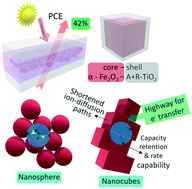Core–shell α-Fe2O3-mixed phase TiO2 nanocubes as a highway for electron transport with efficient energy harvesting
Abstract
Morphology (shape + phase) driven nanoassemblies are emerging materials for faster charge transport and have immense potential for the development of photoelectric devices. α-Fe2O3 (core) nanocubes are synthesized via a facile modified metal-ion mediated hydrothermal method. Mixed-phase (anatase and rutile) TiO2 thin conformal nanoshells (∼15 nm) are decorated on the core by a kinetically controlled process. A high yield (96.37%) of highly monodisperse core–shell α-Fe2O3–anatase + rutile TiO2 nanocubes is obtained. Their phase and detailed crystallographic nature are investigated using XRD and SEM-TEM, respectively. Furthermore, a dye sensitized solar cell (DSSC) is fabricated using the synthesized materials as a photoanode. The device fabricated using core–shell nanostructures as photoanodes demonstrated an 8% and 21% enhancement in the photoconversion efficiency and FF of the solar cell compared to that of α-Fe2O3 photoanodes, respectively. Our results suggest that dye molecules are anchored to the α-Fe2O3–anatase + rutile TiO2 nanocubes more effectively, providing direct pathways for electron (e−) transport and a lower recombination rate (VOC increase by 5%). This study opens a new facile approach for diverse phase dependent core–shell nanocube architecture for a wide range of applications.



 Please wait while we load your content...
Please wait while we load your content...